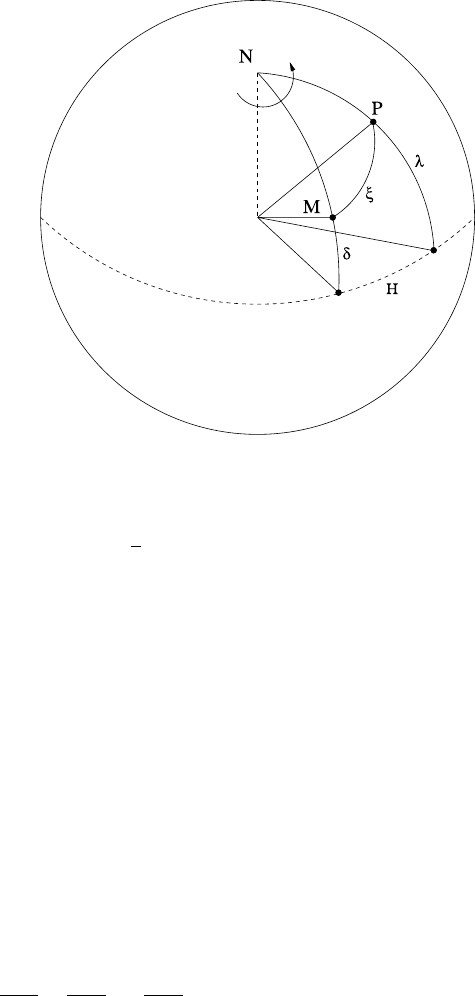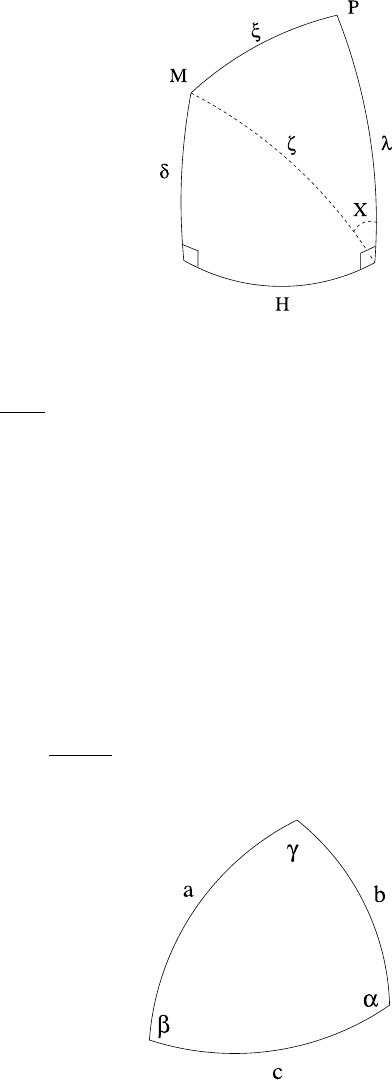Fowler A. Mathematical Geoscience
Подождите немного. Документ загружается.


190 3 Oceans and Atmospheres
with boundary conditions
ψ =0atX =0,ψ→
1
β
as X →∞; (3.230)
the solution is
ψ =
1 −e
βX
β
, (3.231)
and represents a northwards current of magnitude v ∼
1
ε
at the western boundary.
Thus the circulation is highly skewed.
There are also boundary layers adjoining the upper and lower boundaries, and
these are similar to each other. For example, near the lower boundary, we put
y =ε
1/2
Y, (3.232)
so that
−βψ
x
≈1 +ψ
YY
, (3.233)
with boundary conditions
ψ =0atY =0,ψ→
1 −x
β
as X →∞; (3.234)
the appropriate ‘initial’ condition for the parabolic equation (3.233) is that
ψ =0atx =1. (3.235)
(3.233) has a similarity solution, given by
ψ =
1 −x
β
1 −f(η)
,η=
Y
2
β
1 −x
1/2
, (3.236)
where f satisfies the differential equation
f
+2ηf
−4f =0, (3.237)
with boundary conditions
f(0) =1,f(∞) =0. (3.238)
The solution is the error function integral
25
f(η)=i
2
erfc η. (3.239)
25
See Abramowitz and Stegun (1964). The error function integrals are defined iteratively by
i
n
erfcη = i
n−1
erfcη,i
0
erfcη = erfcη, and satisfy the equations f
n
+ 2ηf
n
− 2nf
n
= 0, where
f
n
(η) =i
n
erfcη; this is easily shown inductively by differentiating the equation, which shows that
f
n
=f
n−1
.

3.9 Western Boundary Currents: The Gulf Stream 191
The assumption of a square box is irrelevant to the method of solution. An ar-
bitrary domain will have a solution structure of the same form, with an attached
western boundary layer of thickness O(ε), in which ψ
x
∼ 1/ε. We can now as-
sess the neglect of the lateral drag term in E
H
. The size of this term in the western
boundary layer is O(E
H
/ε
4
), and therefore the boundary layer structure above is
valid, providing E
H
ε
3
, i.e.,
E
H
E
V
2sinλ
3/2
. (3.240)
If we use our estimates, then we have E
H
∼ 0.4 × 10
−7
, (
E
V
2sinλ
)
3/2
∼
0.8×10
−8
(2sinλ)
3/2
,
and (3.240) is barely feasible. This suggests that it may be more realistic to suppose
that the lateral drag term in E
H
controls the western boundary layer structure, and
we now consider its effect. In any case, the basal drag term can only allow the no-
flow-through condition, and the lateral term is necessary to bring the velocity to
zero.
3.9.2 Effects of Lateral Drag
For simplicity, we neglect the basal drag term, so that the model for the stream
function is
βψ
x
=−1 +E
H
∇
4
ψ, (3.241)
together with the conditions
ψ =
∂ψ
∂n
=0on∂B. (3.242)
The outer solution ψ ∼
1−x
β
is as before, and the appropriate rescaling in the
western boundary layer is
x =
X
E
1/3
H
, (3.243)
and then the boundary layer equation is
βψ
X
=ψ
XXXX
, (3.244)
together with the boundary conditions
ψ =ψ
X
=0atX =0,ψ→
1
β
as X →∞. (3.245)
The solution of this is
ψ =
1
β
1 −exp
−
1
2
β
1/3
X
cos
β
1/3
√
3X
2
+
1
√
3
sin
β
1/3
√
3 X
2
; (3.246)
192 3 Oceans and Atmospheres
note the oscillatory decay away from the boundary layer. We leave the solution in
the horizontal boundary layers as an exercise (see Question 3.13).
3.10 Global Thermohaline Circulation
While the surface winds drive an oceanic circulation which is confined to the rel-
atively near surface, there is a deeper circulation which is driven ultimately by the
same source as that which drives the weather systems, that is to say, the radiatively
induced poleward temperature gradient. While the atmospheric circulation can be
viewed as a form of thermal convection mediated by the effects of a strong rotation,
the deep oceanic circulation can be viewed as a form of thermal convection medi-
ated by the strong effects of salinity. As such, this large scale convection is called the
global thermohaline circulation, and it is often, slightly misleadingly, described as a
conveyor belt, with descending water in the North Atlantic travelling southwards as
North Atlantic Deep Water (NADW) to the Antarctic, where the conveyor sends it
to the Indian and Pacific Oceans. There it rises, and eventually returns to the North
Atlantic as surface water.
The poleward convection in the oceans is not affected by rotation in the same way
as it is in the atmosphere, because of the presence of continents. In particular, con-
vection in the Atlantic is channelled by the confining continents of the Americas to
the west, and Europe and Africa to the east, and so it runs north to south. However,
the oceans are saline, and this has a significant effect on the convection, because of
the large contribution of salt to the density. While there is no source or sink of salt,
salinity gradients are generated either by (stabilising) freshwater inputs via conti-
nental river outflow, or by (destabilising) evaporation, which provides a freshwater
vapour flux to the atmosphere and a consequent salinification of the ocean surface.
If we remove the wind-driven circulation from the picture entirely, we think of
competing forms of thermal and saline convection, for example in the North At-
lantic. A purely thermal convection is produced by the equator to pole temperature
gradient, and will cause a convective circulation in the form of a large scale roll. The
Rayleigh number is so enormous that the steady roll may be unstable, with intermit-
tent plumes developing out of the surface boundary layer, but one would expect the
convective style to be essentially circulatory.
If, on the other hand, one removes the thermal buoyancy entirely, then the evap-
oration of the surface waters near the equator will lead to a destabilising surface
salinity, but the consequent convection will be more finger-like, and localised, since
there is no large scale imposed salinity gradient.
Superimposing these two notions, we might suppose a circulatory thermal con-
vection, with the unstable saline surface boundary layer providing a series of lo-
calised downwelling plumes. In practice, such deep water formation regions do in-
deed exist, but there are not many of them. The two principal ones are in the North
Atlantic, which forms the North Atlantic Deep Water, and in the Weddell Sea in
the Antarctic, which forms the Antarctic Bottom Water (ABW). Enormous mix-
ing takes place at the interface between these two water masses, and the Antarctic

3.11 Tides and Tsunamis 193
circumpolar current, which rotates west to east round Antarctica, acts as a kind of
mixer, spraying out the NADW into the Pacific and Indian oceans, where it even-
tually wells up and returns to the North Atlantic surface water by various routes:
through the Drake Passage between South America and Antarctica, from the Arctic
via the Bering Strait, through Indonesia and round South Africa.
Although the origin of the thermohaline circulation may reside in the poleward
thermal gradient, its nature may be largely salinity driven. The Atlantic surface wa-
ters are more saline than those of the Pacific, there being a net freshwater vapour
flux from the Atlantic basin towards the Pacific. As was discussed in Sect. 2.5.7,it
is thought that the rapid climate changes indicated by Dansgaard–Oeschger events
may be associated with switches in the strength of the North Atlantic circulation—
the so-called North Atlantic salt oscillator. The idea of this is that when the circula-
tion is strong, it is warmer in the north, so that ice sheet melting is increased. The
increased freshwater flux to the North Atlantic reduces the salinity of the surface
ocean, thus reducing the air temperature, until eventually the circulation may even
switch off. As the air temperature is reduced, however, melting on the ice sheets
decreases and may cease entirely, allowing the ice sheets to regrow. The consequent
decreased freshwater flux can then allow the oceanic circulation to restart.
3.11 Tides and Tsunamis
We go to the beach, and if we are paying attention, we notice that the tide comes
in twice a day. Most of us know that tides are due to the gravitational attraction
of the Sun and the Moon, and this seems to make sense. The Moon (which has the
dominant effect) exerts an attraction on the water envelope of the oceans, pulling the
water towards the Moon. Since the Earth rotates once a day, the high water remains
stationary with respect to the Moon, and so we get the diurnal tide, apparently. But
why are there then two tides a day? Worse, why is there only one tide a day in
some places, and worst of all why is there sometimes almost no tide at all in certain
locations, for example in the Mediterranean?
The answer to the most obvious of these problems, that of the semi-diurnal tide,
is indicated in Fig. 3.8. Intuitively, we think that the pull of the Moon will cause
a bulge in the oceans only on the side nearest to the Moon. This is because we are
thinking at laboratory scale, and are forgetting the variation of gravity with distance.
The Moon pulls the centre of the Earth with a certain force. On side N of the Earth
in Fig. 3.8, this force is greater, because N is nearer to the Moon; consequently the
ocean surface is pulled towards the Moon. So also is the Earth’s surface, but: the
Fig. 3.8 The attractive effect
of the Moon on the Earth’s
oceans

194 3 Oceans and Atmospheres
Fig. 3.9 Tide-generating
force diagram
Earth is essentially rigid, and this deformation is inconsequential. On the far side of
the Earth, the force of attraction is correspondingly weaker, and relative to the force
on the Earth, the oceans experience a repulsion. Hence the bulge is as shown, and
thus as the Earth rotates, there are two tides a day.
3.11.1 The Tidal Equations
Suppose at a point P on the Earth, the centre of the Moon is at distance r,asshown
in Fig. 3.9. The distance of the centre of the Earth from the centre of the Moon
is denoted d
M
, and the radius of the Earth is r
0
. The fluid envelope of the Earth
experiences the gravitational force due to the Earth, but in addition there is a force
towards the Moon. However, to compute the tide-generating force, we must subtract
from this the attractive force of the Moon on the Earth. Thus the tide-generating
force per unit mass at P is
f
TG
=∇
GM
r
−
GM
d
2
M
i, (3.247)
where i is the unit vector from the centre of the Earth to the centre of the Moon, G
is the gravitational constant, and M is the mass of the Moon. We can equivalently
write this force as the gradient of a potential,
f
TG
=GM∇
1
r
−
r
0
cosξ
d
2
M
. (3.248)
We can simplify this by using the expansion
1
r
=
1
d
M
1 −
2r
0
cosξ
d
M
+
r
2
0
d
2
M
−1/2
=
1
d
M
∞
n=0
r
0
d
M
n
P
n
(cosξ), (3.249)
where P
n
is the nth Legendre polynomial. Now r
0
d
M
; substituting (3.249)into
(3.248) and retaining the first significant term, we obtain
f
TG
≈
GMr
2
0
d
3
M
∇
P
2
(cosξ)
. (3.250)

3.11 Tides and Tsunamis 195
Fig. 3.10 Spherical
trigonometry relating the
angle ξ to the hour angle H ,
the declination δ,andthe
latitude λ. M indicates the
position of the
tide-generating body (e.g., the
Moon), and P is the local
position on the Earth
The second Legendre polynomial is defined by
P
2
(cosξ)=
1
2
3cos
2
ξ −1
. (3.251)
Next we need to identify the angle ξ in terms of the normal angles of spherical
polar coordinates. To do this we need a little spherical trigonometry. The geometry
of the situation is indicated in Fig. 3.10, where we take the sphere radius to be one,
without loss of generality. We want to relate the angle ξ to the declination of the
Moon δ, the latitude λ, and the so-called hour angle H . This is simply longitude,
except that the rotation of the Earth causes it to increase with time, specifically
H =ωt +φ, (3.252)
where ω is the angular speed of rotation of the Earth. The bare bones of Fig. 3.10
are shown in Fig. 3.11. To relate ξ to the other variables, we consider triangles on
the unit sphere, such as that shown in Fig. 3.12. If the lengths of the sides are a, b,
c, and the corresponding opposite angles are α, β and γ , then we have the following
formulae, which are, respectively, the first cosine rule and the sine rule:
cosa =cos b cos c +sin b sin c cos α,
sin α
sin a
=
sinβ
sinb
=
sin γ
sin c
.
(3.253)
Applying these formulae to the two triangles in Fig. 3.11 which constitute the
quadrilateral, and bearing in mind that the two basal angles are right angles, we

196 3 Oceans and Atmospheres
Fig. 3.11 The spherical
quadrilateral
derive the formulae
sin ζ =
sin δ
cosX
,
cosξ = cosζ cos λ +sin δ sin λ, (3.254)
cosζ =cosδ cos H,
and from these we find
cosξ =sin λ sin δ +cos λ cos δ cos H. (3.255)
Finally, the tide-generating force can be written as
f
TG
=D∇χ, (3.256)
where
D =
3GMr
2
0
4d
3
M
(3.257)
Fig. 3.12 Sides and angles of
a spherical triangle

3.11 Tides and Tsunamis 197
is known as the Doodson number (although it has dimensions), and χ = 2cos
2
ξ ,
whence
χ =cos
2
λ cos
2
δ cos 2H +sin 2λ sin 2δ cos H +
cos
2
λ cos
2
δ +2sin
2
λ sin
2
δ
.
(3.258)
The time dependence of the forcing is expressed in the hour angle H, and we see that
the three components represent, respectively, a semi-diurnal forcing (∝ cos 2H ),
a diurnal forcing (∝ cos H ), and a ‘long period’ forcing, independent of Earth’s
rotation, but dependent on longer term orbital variations. Evidently the comparable
but smaller effect of the Sun can be considered in the same way, and will add further
ingredients to the tide-generating force.
Our model for tides is based on the Eqs. (3.1), except applied to an incompress-
ible ocean. We use a depth integrated shallow water theory with a free upper bound-
ary, but it is convenient to write the shallow water equations in vector form, delaying
the intricacies of spherical polar coordinates until later. We define a vertical coordi-
nate
z =r −r
0
, (3.259)
and we denote the ocean surface as z =η, and the ocean floor as z =b. The ocean
depth is thus h =η −b, and we suppose that the depth-averaged horizontal velocity
field is u. From first principles, mass conservation yields the equation
∂h
∂t
+∇.(hu) =0, (3.260)
where ∇ denotes the horizontal gradient vector. The (horizontal) momentum equa-
tion is obtained from (3.1), and is
ρ
du
dt
+2
3
×u
=−∇p +ρD∇χ. (3.261)
In deriving this (note that u and ∇ are horizontal) we have integrated over the depth
and then used the mass conservation equation. The term 2
3
×u is the horizontal
component of the Coriolis force, which is obtained by defining
3
to be the vertical
(in the z direction) component of the Earth’s angular velocity. In addition, shallow
water theory implies that
p ≈ρg(η −z), (3.262)
and thus
∇p ≈ρg∇η. (3.263)
Next we scale the equations. We denote the horizontal distance vector on the
sphere as x, and we define a dimensionless parameter ε as
ε =
D
gd
, (3.264)

198 3 Oceans and Atmospheres
where d is mean ocean depth. Values of D/g are 0.27 m for the Moon, and 0.12 m
for the Sun, while d ≈3,800 m, so the parameter ε is very small, having a typical
value of order 10
−4
. We scale the variables as follows:
x ∼r
0
,η∼εd, b, h ∼d, u ∼ε
gd, t ∼
r
0
√
gd
, (3.265)
and this yields the non-dimensional system
η
t
+∇.(hu) = 0,
h =−b +εη, (3.266)
u
t
+ε(u.∇)u +2S sinλ k ×u =−∇η +∇χ,
where k is the unit vector in the vertical,
S =
ωr
0
√
gd
(3.267)
is a Strouhal number, and χ is given by (3.258), with now
H =φ +St. (3.268)
With values ω = 7.27 ×10
−5
s
−1
, r
0
= 6.37 × 10
6
m, g = 9.8ms
−2
, d = 3.8 ×
10
3
m, we find S ≈2.4. Neglecting terms of O(ε) in (2.19), we have the tidal model
η
t
+∇.(hu) =0,
u
t
+2S sin λ k ×u =−∇η +∇χ,
(3.269)
in which we can take h(x) independent of time.
3.11.2 Ocean Tides
We begin by taking uniform depth h = 1 and ignoring the Coriolis force, thus we
put S =0in(3.269)
2
(but not in the definition of χ). From this there follows
η
t
+∇. u =0,
u
t
=−∇η +∇χ,
(3.270)
whence
η
tt
=∇
2
η −∇
2
χ. (3.271)
In the spherical polar coordinates φ and λ,
∇ =
1
cosλ
∂
∂φ
,
∂
∂λ
, cos
2
λ ∇
2
=
∂
2
∂φ
2
+
∂
2
∂ν
2
, (3.272)

3.11 Tides and Tsunamis 199
(cf. (3.28)), where we define
ν =ln
1 +tan(λ/2)
1 −tan(λ/2)
,
∂
∂ν
=cos λ
∂
∂λ
. (3.273)
The tide-generating potential given by (3.258) contains separate components due to
semi-diurnal, diurnal, and long period variations. The combined effect of these (and
of the tidal effects of the Sun) can be obtained by linear superposition. For simplicity
we will consider only the semi-diurnal lunar tide, denoted M
2
, and suppose that the
tide-generating potential is just
χ =cos
2
δ cos
2
λ cos 2(φ +St). (3.274)
Newton’s equilibrium theory (illustrated in Fig. 3.8) assumes that η = χ,butev-
idently this could only be approximately valid for slowly varying χ, i.e., S 1.
This is not the case on the Earth, and consequently the times of high tides lag the
times of maximum attractive force.
The simplest case to consider is that of a narrow canal at a fixed latitude, which
circumtraverses the globe. To obtain a solution in this case, we write (3.271)inthe
form (using (3.268) and (3.272))
S
2
cos
2
λη
HH
=
∂
2
∂H
2
+
∂
2
∂ν
2
(η −χ), (3.275)
where we assume that η depends only on the combination H =φ +St. Supposing
the variation of ν is small, we write η =η
(0)
+η
(1)
+···,etc.,
26
and then we have
to leading order
η
(0)
−χ
(0)
≈f(H), (3.276)
and at the next order
∂
2
(η
1
−χ
(1)
)
∂ν
2
=
S
2
cos
2
λ −1
f
+S
2
cos
2
λχ
HH
. (3.277)
The boundary conditions of no flow through the side walls require η
ν
−χ
ν
=0, and
therefore integration of (3.277) between the walls gives an integrability condition
for its solution; this determines f and thus η (omitting the superscript zero), and the
result is
η =
χ
1 −S
2
cos
2
λ
. (3.278)
This represents a westward travelling wave of speed −S (since χ ∝φ +St), whose
amplitude is modulated by latitude.
At the equator, λ =0 and (since S>1) the canal tides are out of phase with the
tide-generating potential (the lag time is one quarter of a lunar day, slightly over
26
To be more formal, we would write ν =ν
0
+ε ˜ν,takeε (here denoting the dimensionless canal
width) to be small, expand as η =η
(0)
+ε
2
η
(1)
+···, and so on, but the end point is the same.
